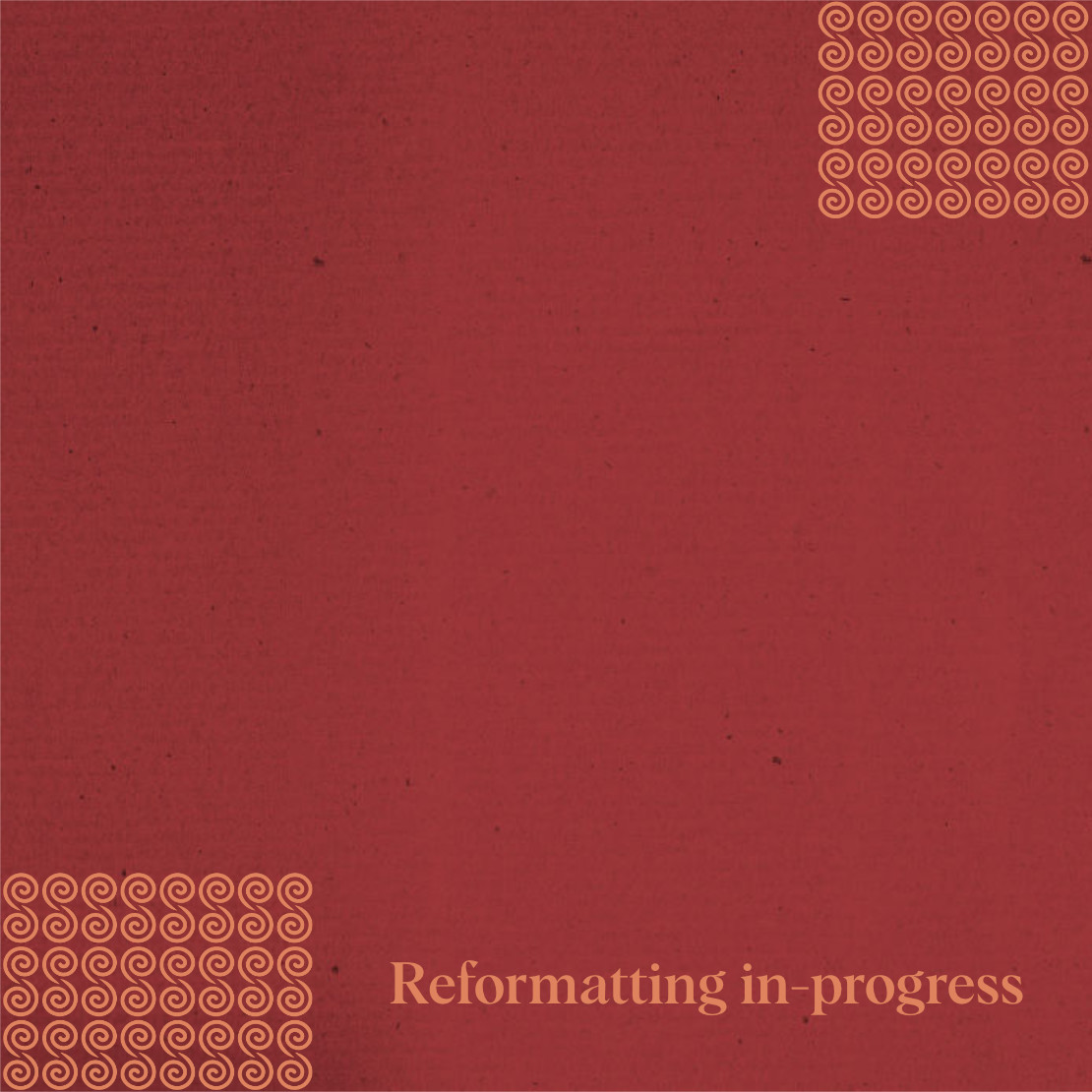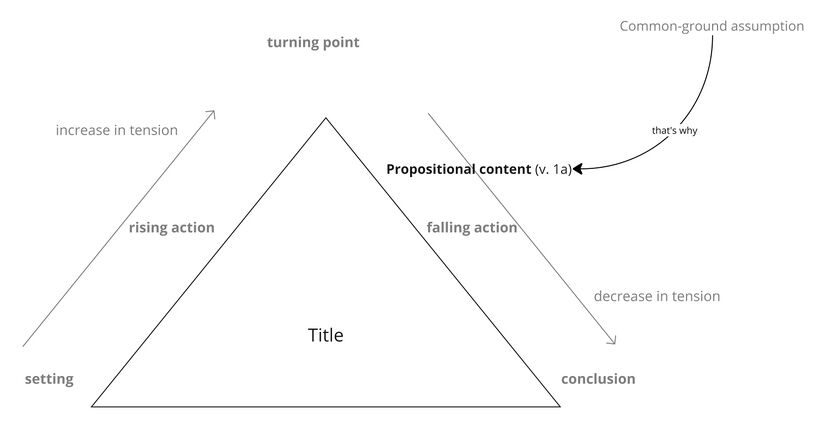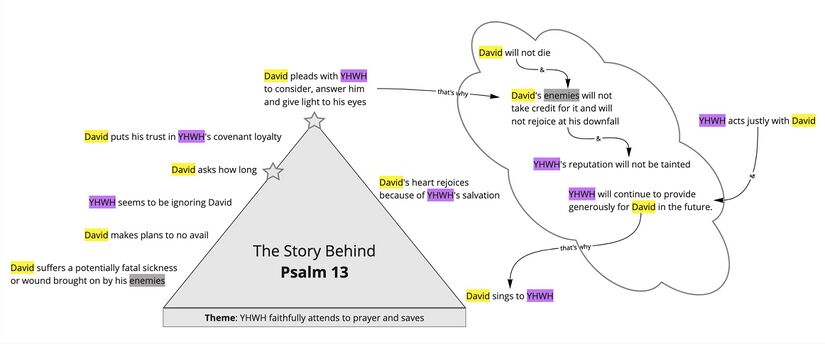Psalm 13 Story Behind
About the Story Behind Layer
The Story Behind the Psalm shows how each part of the psalm fits together into a single coherent whole. Whereas most semantic analysis focuses on discrete parts of a text such as the meaning of a word or phrase, Story Behind the Psalm considers the meaning of larger units of discourse, including the entire psalm.
The goal of this layer is to reconstruct and visualize a mental representation of the text as the earliest hearers/readers might have conceptualized it. We start by identifying the propositional content of each clause in the psalm, and then we identify relevant assumptions implied by each of the propositions. During this process, we also identify and analyze metaphorical language (“imagery”). Finally, we try to see how all of the propositions and assumptions fit together to form a coherent mental representation. The main tool we use for structuring the propositions and assumptions is a story triangle, which visualizes the rise and fall of tension within a semantic unit. Although story triangles are traditionally used to analyze stories in the literary sense of the word, we use them at this layer to analyze “stories” in the cognitive sense of the word—i.e., a story as a sequence of propositions and assumptions that has tension.
Summary Triangle
The story triangle below summarises the story of the whole psalm. We use the same colour scheme as in Participant Analysis. The star icon along the edge of the story-triangle indicates the point of the story in which the psalm itself (as a speech event) takes place. We also include a theme at the bottom of the story. The theme is the main message conveyed by the story-behind.
| Story Triangles legend | |
|---|---|
| Propositional content (verse number) | Propositional content, the base meaning of the clause, is indicated by bold black text. The verse number immediately follows the correlating proposition in black text inside parentheses. |
| Common-ground assumption | Common-ground assumptions[1] are indicated by gray text. |
| Local-ground assumption | Local-ground assumptions[2] are indicated by dark blue text. |
| Playground assumption | Playground assumptions[3] are indicated by light blue text. |
| The point of the story at which the psalm takes place (as a speech event) is indicated by a gray star. | |
| If applicable, the point of the story at which the psalm BEGINS to take place (as a speech event) is indicated with a light gray star. A gray arrow will travel from this star to the point at which the psalm ends, indicated by the darker gray star. | |
| A story that repeats is indicated by a circular arrow. This indicates a sequence of either habitual or iterative events. | |
| A story or event that does not happen or the psalmist does not wish to happen is indicated with a red X over the story triangle. | |
| Connections between propositions and/or assumptions are indicated by black arrows with small text indicating how the ideas are connected. | |
| Note: In the Summary triangle, highlight color scheme follows the colors of participant analysis. | |
Background ideas
Following are the common-ground assumptionsCommon-ground assumptions include information shared by the speaker and hearers. In our analysis, we mainly use this category for Biblical/Ancient Near Eastern background. which are the most helpful for making sense of the psalm.
- The question "How long? signals lament. It it not really a question, but rather, in speech act terms, an expressive. Similar expressions are known from ancient Mesopotamia, often in prayers for healing.
- Sickness was viewed as just as dire a situation as a battle wound, brought on by men's curses and overcome by YHWH's compassion.
- The expression "to hide one's face" is used several times in the Psalms, in the sense of turning a blind eye to the suffering of the innocent (Pss 10:11; 13:2; 22:25; 27:9; 30:8; 44:25; 51:11; 69:18; 88:15; 102:3; 104:29 (obj.: animals); 143:7).
- YHWH promised to David that:
- he would one day be king (1 Sam 16:1, 12),
- his house and kingdom would be established forever (2 Sam 7:16).
Background situation
The background situation is the series of events leading up to the time in which the psalm is spoken. These are taken from the story triangle – whatever lies to the left of the star icon.

Expanded Paraphrase
The expanded paraphrase seeks to capture the implicit information within the text and make it explicit for readers today. It is based on the CBC translation and uses italic text to provide the most salient background information, presuppositions, entailments, and inferences.
| Expanded paraphrase legend | |
|---|---|
| Close but Clear (CBC) translation | The CBC, our close but clear translation of the Hebrew, is represented in bold text. |
| Assumptions | Assumptions which provide background information, presuppositions, entailments, and inferences are represented in italics. |
| Text (Hebrew) | Verse | Expanded Paraphrase |
|---|---|---|
| לַמְנַצֵּ֗חַ מִזְמ֥וֹר לְדָוִֽד׃ | 1 | For the director. A psalm by David. |
| עַד־אָ֣נָה יְ֭הוָה תִּשְׁכָּחֵ֣נִי נֶ֑צַח עַד־אָ֓נָה ׀ תַּסְתִּ֖יר אֶת־פָּנֶ֣יךָ מִמֶּֽנִּי׃ | 2 | How long, YHWH? I'm in distress and I'm bringing my lament to you, since we have a covenant relationship. Will you ignore me forever? You promised me that you would establish my kingdom forever, but it doesn't look like that now. How long will you hide your face from me and not see or do anything about my unjust suffering? |
| עַד־אָ֨נָה אָשִׁ֪ית עֵצ֡וֹת בְּנַפְשִׁ֗י יָג֣וֹן בִּלְבָבִ֣י יוֹמָ֑ם עַד־אָ֓נָה ׀ יָר֖וּם אֹיְבִ֣י עָלָֽי׃ | 3 | How long will I make (futile) plans and keep worrying about my troubles? [How long] will sorrow be daily in my heart? You promised to give me rest from all my enemies. Yet my enemy is apparently winning . How long will my enemy be exalted over me? |
| הַבִּ֣יטָֽה עֲ֭נֵנִי יְהוָ֣ה אֱלֹהָ֑י הָאִ֥ירָה עֵ֝ינַ֗י פֶּן־אִישַׁ֥ן הַמָּֽוֶת׃ | 4 | Consider stop ignoring me, and pay attention to me instead! Answer me, YHWH who because we are in covenant together, I appeal to as my God! I am weak and near death because of the wound from my enemy / because of my illness, so Give light to my eyes and restore my health and vigour as I know you're able, lest I sleep permanently in death, |
| פֶּן־יֹאמַ֣ר אֹיְבִ֣י יְכָלְתִּ֑יו צָרַ֥י יָ֝גִ֗ילוּ כִּ֣י אֶמּֽוֹט׃ | 5 | lest my enemy say, “I have overpowered him!” [lest] my adversaries rejoice because I am shaken. |
| וַאֲנִ֤י ׀ בְּחַסְדְּךָ֣ בָטַחְתִּי֮ יָ֤גֵ֥ל לִבִּ֗י בִּֽישׁוּעָ֫תֶ֥ךָ אָשִׁ֥ירָה לַיהוָ֑ה כִּ֖י גָמַ֣ל עָלָֽי׃ | 6 | But I have put my trust in your covenant loyalty. I know that you will answer my prayer and save me. Let my heart rejoice because of your salvation which I can expect is coming soon because of your covenant promises! I will sing to YHWH, because he has repaid me and will continue to act justly toward me in the future! |
Story Triangles
There are currently no Imagery Tables available for this psalm.
Bibliography
Footnotes
- ↑ Common-ground assumptions include information shared by the speaker and hearers. In our analysis, we mainly use this category for Biblical/ANE background - beliefs and practices that were widespread at this time and place. This is the background information necessary for understanding propositions that do not readily make sense to those who are so far removed from the culture in which the proposition was originally expressed.
- ↑ Local-ground assumptions are those propositions which are necessarily true if the text is true. They include both presuppositions and entailments. Presuppositions are those implicit propositions which are assumed to be true by an explicit proposition. Entailments are those propositions which are necessarily true if a proposition is true.
- ↑ Whereas local-ground assumptions are inferences which are necessarily true if the text is true, play-ground assumptions are those inferences which might be true if the text is true.







